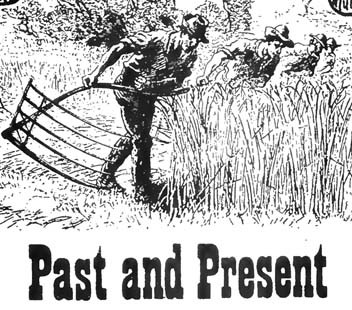Maybe it was the recent election of Richard Nixon to the White House that left me looking to the past rather than to the future in 1974. That was the year I published Honest Abe’s Honest Almanac. The little book was, as its subtitle promises, “a cornucopia of amazing facts, useful wisdom and amusing anecdotes concerning the social, political, economic, recreational, educational and cultural life of Springfield, Illinois, past and present.” Among those amazing facts was this one, which appeared on page 29: “The Mason-Dixon Line, which has traditionally been considered the boundary line between the Northern and Southern states in the U.S., passes just 4.56 miles due south of the Illinois statehouse… .”
The line was surveyed by Charles Mason and Jeremiah Dixon in the 1760s, in part to define a segment of the border between colonial Pennsylvania and Maryland. The precise location of the line varies slightly, depending on where along its length one measures it, but 39 degrees 43 minues 20 seconds north latitide is close. Were that line extended westward across Illinois it would run roughly midway between I-72 and Woodside Road. That puts much of Lake Springfield in what we could call the Shallow South, including the old Bridgeview Beach. Maybe that’s why the city fathers chose that part of the lake for the city’s blacks-only swimming beach in 1935.
Ordinarily such trivia would be expected to linger in the public memory no longer than the paper it was printed on, which being newsprint, would not have been very long. However, the odd coincidence of Lincoln’s hometown being within spittin’ distance of the South proved as irresistible to others as it did to me 36 years ago. The Web site of the Springfield Convention and Visitors Bureau, for instance, passes it on intact: “This traditional boundary between North and South passes less than five miles south of the Old State Capitol.” The travel advisor at Ehow.com, the Web how-to site, in contrast shows a Blagovian indifference to facts in its version. “Go 5 miles south of Springfield to find the famed Mason-Dixon line,” it reads, “the boundary that separated the North from the South during the slavery era.” The directions overshoot the actual location by nearly a half-mile and are vague about the point from which the distance is to be measured, and there is no marker or monument to see there anyway.
I wrote that the Mason-Dixon Line was “traditionally” considered the boundary line between the Northern and Southern states, but failed to point out that the tradition was hooey. The original line was drawn to settle the boundaries of two adjacent royal land grants, not to define regions of the not-yet-born United States.
Decades after it was surveyed, the term “Mason-Dixon Line,” if not the line itself, came into general use to denote the border in one of our great national contests. But which border? The term has been used, indeed is still used, to distinguish Northern and Southern states, Union and the Confederate states and free states and slave states. Each of these groups comprise different states, so the boundaries that divide them vary, but the actual Mason-Dixon Line traces the route of none of them.
To the extent that a north-south boundary was officially described, it was in the Missouri Compromise of 1820. That batch of congressional fudge banned the introduction of slavery into new territories carved out of the Louisiana Purchase that lay north of 36 degrees 30 minutes latitude. That line runs miles south of the Mason-Dixon Line, so far south that it skirts Illinois altogether.
Calling the original Mason-Dixon Line the boundary between North and South thus is like saying that Fifth Street marks the boundary between Democratic and Republican Springfield. So why include it in an almanac of historical facts? Because — as so often happens — what the actual Mason-Dixon Line was matters less than what it was employed to mean. For instance, the near presence of that line of latitude was a useful rhetorical device, a way to suggest by shorthand a complex phenomenon. “Springfield is a northern city,” I wrote in the almanac, “but just barely, a fact that has shaped our history in more ways than one.” The rivers that then served Illinois as highways all penetrated the state’s interior from the South, which made central Illinois convenient to settlers from Kentucky, Tennessee and the rest of the upland South. From its beginning, then, Springfield might have been the capital of a great Northern state, but it was, in its racial attitudes, its political culture, even its preferences in urban form, a deeply Southern place. Not because of a line on the map, but because of its history.
Note: Honest Abe’s Honest Almanac can be downloaded free by anyone with a computer internet link and more time to waste than is healthy, at http://www.archive.org/details/honestabeshonest00kroh
Contact James Krohe Jr. at [email protected].
Drawing the line?
Springfield as a border town on the North-South divide

[
{
"name": "Air - MedRect Combo - Inline Content 1",
"component": "11490391",
"insertPoint": "3",
"requiredCountToDisplay": "1",
"parentWrapperClass": "fdn-ads-inline-content-block"
},{
"name": "Air - MedRect Combo - Inline Content 2",
"component": "11490392",
"insertPoint": "7",
"requiredCountToDisplay": "5",
"parentWrapperClass": "fdn-ads-inline-content-block"
},{
"name": "Air - MedRect Combo - Inline Content 3",
"component": "11490393",
"insertPoint": "12",
"requiredCountToDisplay": "9",
"parentWrapperClass": "fdn-ads-inline-content-block"
}
]


